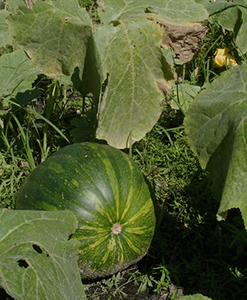Seminole Pumpkin

Traditionally grown by the Calusa, Creek, and Miccosukee peoples, Seminole pumpkins remain one of the tastiest and most reliable pumpkins for Florida gardens. The Seminole people gave the name “Chassahowitza” to a region on the gulf in Southwest Florida. The name means “pumpkin hanging place.” It’s likely that the pumpkins they were referring to were Seminole pumpkins, or a related variety.
Gardeners in the Sunshine State sometimes struggle to find vegetables that will make it through our relentless summer heat. Florida’s Seminole pumpkins just may be the answer to their search!
Characteristics

Seminole pumpkins are a cultivated variety (cultivar) of Cucurbita moschata. Other notable cultivars of this species include butternut squash and calabaza. While generally rounded and dull orange, Seminole pumpkins come in a variety of shapes and colors. Sometimes this is the result of cross-pollination with nearby butternut squash or another member of their species. Regardless, the inner flesh of Seminole pumpkin is orange, similar to butternut squash, but sweeter. The flesh is firmer and less fibrous than that of a traditional jack-o-lantern pumpkin (Cucurbita pepo). Mature fruits generally weigh 6 to 12 pounds.
To preserve their harvest of Seminole pumpkins, aboriginal Floridians sliced and dried the fruit. Thanks to their thick skin, Seminole pumpkins can be stored whole for a couple of months, even in Florida’s humid climate. In a dry location with good ventilation, they can be stored for up to a year.
Seminole pumpkin makes an excellent substitute for pumpkin or butternut squash when cooking. You don’t have to limit yourself to eating the flesh of these pumpkins, either. Young, green fruits can be harvested and eaten without peeling. The beautiful yellow flowers are also edible raw, stuffed, or even fried.
Planting and Care
Gardeners in frost-free areas of the state have the opportunity to plant Seminole pumpkin between August and March. In North and Central Florida, seeds can be planted in the spring. This is usually between February and April, but could be as late as July if you can commit yourself to vigilant pest management. Many gardeners choose to plant late, knowing that it is one of the few veggies that can survive a harsh Florida summer. Some gardeners also plant in the fall, but only do so if you have 120 days left before the first frost is expected.

As with other squashes, we recommend direct-seeding in an area that gets 6-8 hours of direct sunlight. These productive vines can grow to 25 feet or more, so give them room to spread. The Seminole people planted the vines below trees, which served as natural trellises. In your garden the vines will spread widely. Space the plants 4 feet apart, with rows 6-9 feet apart or install a trellis for the vines to climb.
Seminole pumpkins require pollination of the female flowers (the ones with a round base) to produce fruit. Plant some flowers nearby to encourage pollinators to visit your pumpkins. Within three to four months of planting you should be ready to pick the first Seminole pumpkins. They are mature when the color ripens to a sandy orange. Once harvested, store them in a cool, dry place. Your vine should continue producing fruit up until the first frost of the year.

Seminole pumpkins take the summer heat and humidity in stride and require little maintenance; some gardeners even claim they thrive on neglect. As your vines grow, they may become weighed down by the pumpkins — this is normal for fruiting vines and not something to worry about. Pumpkins that grow hanging from the vine are usually tear-drop shaped, while fruit that develops on the ground more closely resembles a traditional pumpkins.
While these plants don’t suffer from many of the usual summer vegetable pests and diseases, they are not pest free. Gummy stem blight occurs occasionally. You can help prevent this fungal disease by keeping mulch away from the base of your vine and watering only in the early morning.
You should also keep an eye out for caterpillar infestations as the weather warms up. Scout frequently, paying special attention to the newest leaves. If you notice that your plants are being chewed by caterpillars, you can hand pick off the pests or use biological pesticides like Bt.
If you need more information on growing this delicious—and often forgotten—traditional Florida vegetable, contact your county Extension office.
